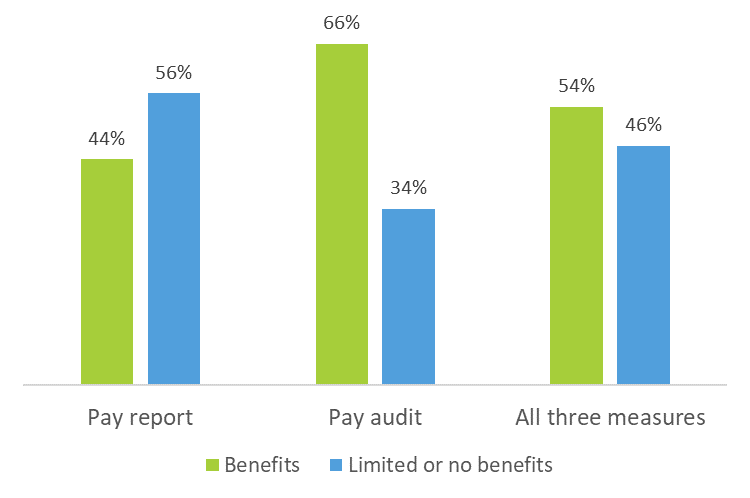Following a sluggish response by many Member States to introduce or modify gender pay transparency measures, as it recommended in 2014, the European Commission intends to table a proposal for EU-level legislation on pay transparency later in 2020. In this context, a new Eurofound study investigated whether key people at company level see these measures as useful or beneficial. The results show that the richer pay audits are favoured over the simpler pay reports in terms of their perceived usefulness. Both managers and employee representatives agree on this.
Embedding the ‘work of equal value’ principle in measures
Three of the measures proposed by the pay transparency recommendation of 2014 specifically targeted companies: the right to obtain information, pay reports and pay audits (see the box further down for details on each). As the undervaluation of women’s work has been suggested as a contributor to the gender pay gap, one lever to reduce it within companies is to ensure that not only are similar positions paid equally, but so too are jobs which are comparable in terms of their ‘value’ (e.g. the nature of work, training and working conditions).
This concept of ‘work of equal value’ still lacks a clear definition, the recommendation notes and therefore suggests that national legislation could seek to fill this gap. Gender-neutral job evaluation and classification schemes – based on collective agreements or set up internally in companies – could be reviewed in pay audits. Implementing the right to obtain information also requires some thinking along these lines, as this involves using comparators of employees doing work of equal value. Pay reports, in contrast, lack this element and are, in their simplest form, a breakdown of pay into job positions or payment quartiles.
Eurofound’s study, which covered the Member States that have implemented at least one of these measures – 13 in all, plus the United Kingdom – finds that the pay reports tend to cover less than half of the employees in many of those countries which have that measure in place. The more complex pay audits are typically obligatory in larger companies only, meaning they cover even fewer employees overall. In addition, few countries have made gender pay transparency obligations compulsory for the public sector as well.
Three gender pay transparency measures:
- Right to obtain information: Employees can request information on pay levels, broken down by gender, for categories of employees doing the same work or work of equal value.
- Pay reports: Employers with at least 50 employees should regularly compile reports on the average remuneration by category of employee or position, broken down by gender.
- Pay audits: Companies with at least 250 employees should carry out audits, which include an analysis of the proportion of women and men in each category of employee or position, an analysis of the job evaluation and classification system used, and detailed information on pay and pay differentials on grounds of gender.
Is the glass half full or half empty?
The study interviewed managers and employee representatives about the pay transparency measures, and half said that they find the measures to be beneficial. A quarter said that the benefits are limited or that the measures would be more useful if they, or the company practice in applying them, were altered. One-fifth of interviewees regard the measures negatively and do not see any benefits to them – this was usually linked to criticism of specificities of the national legislation.
Apart from creating awareness, the benefits most commonly mentioned by managers are that the measures establish the facts around pay differences between male and female employees and promote trust by reassuring staff that pay has been set in a fair way. Managers also reported benefits in getting deeper insights into pay structures – beyond equal pay – which informs future pay setting or negotiations. Some also use these tools for recruiting and promotion. One Swedish HR specialist, for instance, said:
The groundwork for the pay audit provides good ground for deciding what salaries and tasks newly recruited employees should have. It is also beneficial because it provides the employees in the company, who are informed about the pay audit procedure, with a feeling that the company administration actively works to prevent salary discrimination.
The employee representatives – who tended to have a more positive assessment than managers – were largely in agreement on both the types of benefits as well as the limitations of the measures.
Richer analysis is preferred by both sides of industry
Pay audits were regarded as beneficial by more respondents (66% saying so) than pay reports (44%). Many from both sides of industry are critical of the limitations of the pay reports and suggested that they should go further in terms of analysis, for instance by including additional breakdowns (by seniority or job tasks perhaps), by being carried out separately for different units, or by including a longitudinal perspective. One Danish HR manager remarked that the pay reports needed to be interpreted carefully as they ‘can both show and hide inequalities’. A Belgian HR professional sees pay reports as ’demonstrating everything and nothing’, whereas pay audits can convince staff ’that wages are set in a fair, transparent manner (respecting actual seniority, no different pay levels for employees with the same background)’, which ‘prevents tensions and improves employee retention’.
Figure: Responses of interviewees when asked whether the different gender pay transparency measures are beneficial
Note: ‘All three measures’ additionally includes the right to obtain information. See the endnote for a caveat.
Source: Eurofound (2020)
The research also showed that the measures tend to be relatively cheap, and the cost of implementing them does not appear to be a major obstacle for the companies in the study.
Could the ‘work of equal value’ principle bring value to existing measures?
Even among interviewees who find the pay reports useful – somewhat less than half of those interviewed – it was felt that they tend to reach their limits relatively soon. Many stressed that more and richer data and analysis are required if one wishes to detect gender pay gaps, especially in relation to the principle of work of equal value. Most of the measures implemented in Member States do not contain this principle to date.
The study has shown that the richer forms of pay transparency measures – pay audits – if organised and supported well, do not seem to present major problems for companies and can be carried out in a cost-efficient way. And stakeholders are more supportive of them. Therefore, a new focus on adapting existing pay transparency schemes or introducing new ones that by design take into account the work of equal value principle could turn out to be a valuable impetus from the EU level.
Image © Monkey Business/Adobe Stock

